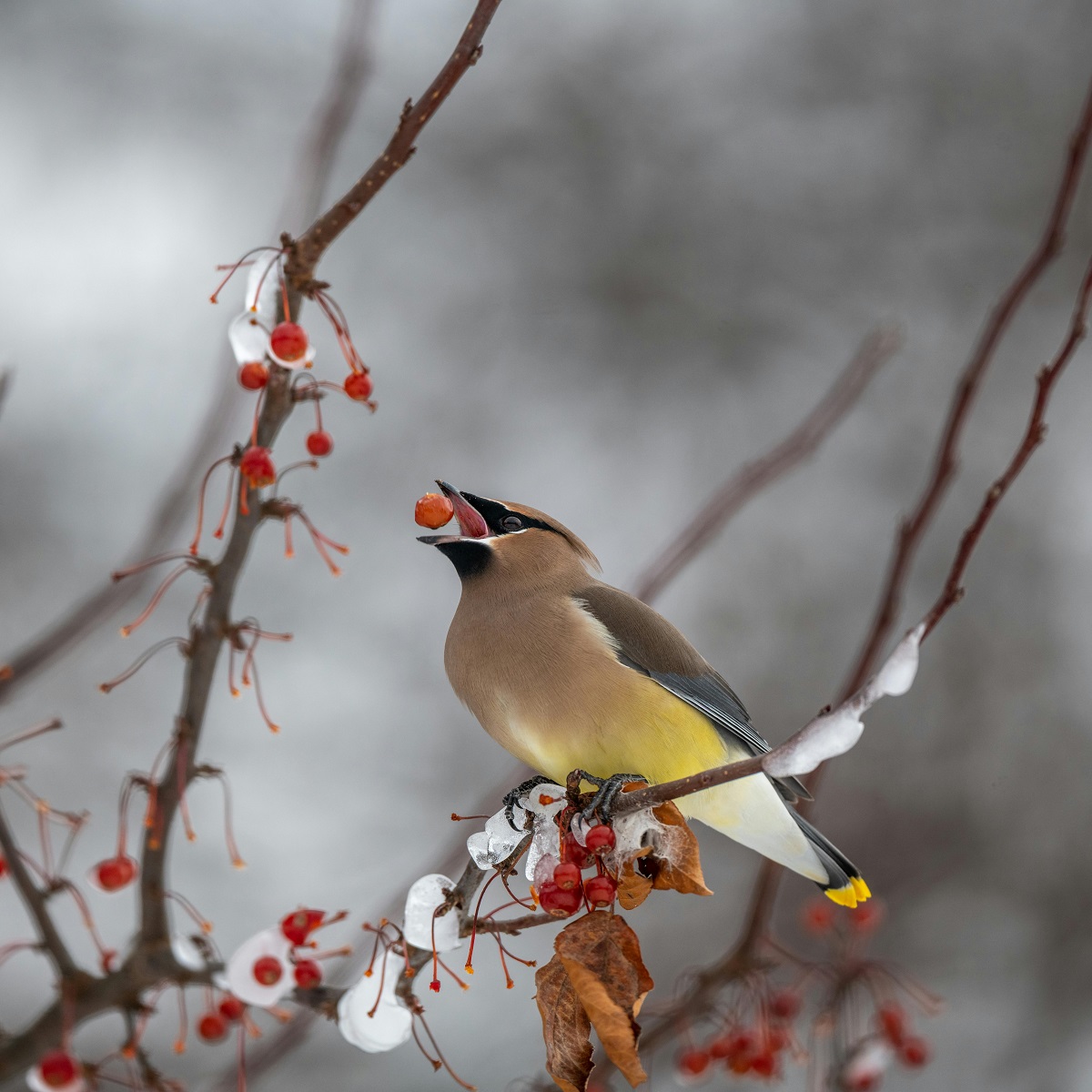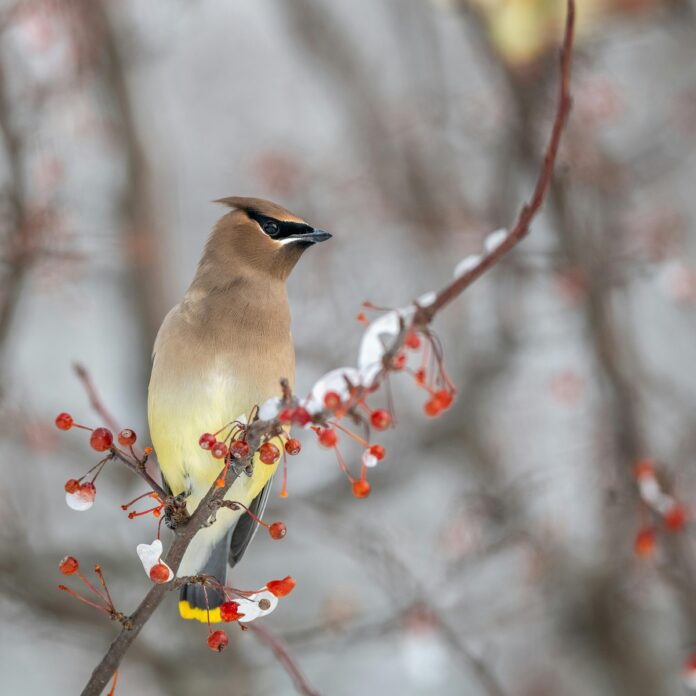The cedar waxwing is one of North America’s most elegant and striking birds. Known for its sleek appearance, silky feathers, and playful behavior, this bird is a favorite among birdwatchers and nature lovers. Cedar waxwings are social birds that travel in flocks and are often seen feasting on berries. Their unique features and fascinating habits make them a joy to observe. Let’s dive into the world of the cedar waxwing and learn about its life, behavior, and role in nature.
What is a Cedar Waxwing?

| Category | Details |
|---|---|
| Common Name | Cedar Waxwing |
| Scientific Name | Bombycilla cedrorum |
| Class | Aves (birds) |
| Order | Passeriformes (perching birds) |
| Family | Bombycillidae (waxwings) |
| Habitat | Forests, orchards, parks, suburban areas (North America) |
| Distribution | North America (breeds in Canada and northern U.S.; winters in southern U.S., Mexico, and Central America) |
| Size | 6–7 inches in length; wingspan of 8.7–11.8 inches |
| Weight | 1–1.2 ounces |
| Lifespan | Up to 8 years in the wild |
| Diet | Frugivorous (berries, fruits, insects) |
| Unique Features | Red waxy tips on wing feathers, yellow tail tip, black mask, sleek plumage |
| Reproduction | Monogamous; 3–5 eggs per clutch; chicks fledge in 14–18 days |
| Conservation Status | Least Concern (stable population) |
| Predators | Hawks, owls, and other birds of prey |
| Adaptations | Social feeding, synchronized flying, ability to digest fermented fruit |
The cedar waxwing (Bombycilla cedrorum) is a medium-sized songbird. It belongs to the family Bombycillidae, which includes only three species of waxwings. The cedar waxwing is named for its love of cedar berries and the waxy red tips on its wing feathers. These waxy tips are unique to waxwings and are a key feature of the species.
Cedar waxwings are known for their smooth, silky plumage. They have a pale brown head, a black mask around their eyes, and a bright yellow tip on their tail. Their wings are gray with red waxy tips, and their bellies are a soft yellow. Their overall appearance is sleek and polished, making them one of the most beautiful birds in the wild.
Habitat and Distribution
Cedar waxwings are found across North America. They live in a variety of habitats, including forests, orchards, parks, and suburban areas. They prefer areas with plenty of fruit-bearing trees and shrubs, which provide them with food and shelter.
Cedar waxwings are migratory birds. They breed in the northern parts of North America, including Canada and the northern United States. In the winter, they migrate to the southern United States, Mexico, and Central America. Some cedar waxwings stay in one place year-round if food is available.
Diet and Feeding Habits
Cedar waxwings are frugivores, meaning they primarily eat fruit. Their diet consists of berries, cherries, and other small fruits. They are especially fond of cedar berries, juniper berries, and holly berries. Cedar waxwings also eat insects, especially during the breeding season when they need extra protein.
Cedar waxwings are social feeders. They often travel in flocks and can be seen perched in trees, passing berries to one another. This behavior is called “social feeding” and is a unique trait of waxwings. They are also known for their ability to catch insects in mid-air, a skill called “hawking.”
One interesting fact about cedar waxwings is that they can become intoxicated. This happens when they eat overripe or fermented berries. Intoxicated waxwings may act strangely, such as flying clumsily or sitting still for long periods. While this behavior is rare, it is a reminder of their love for fruit.
Behavior and Social Life
Cedar waxwings are highly social birds. They are rarely seen alone and usually travel in flocks. These flocks can range from a few birds to hundreds of individuals. Cedar waxwings are known for their gentle and peaceful nature. They rarely fight or compete with each other.
Cedar waxwings are also very vocal. They communicate with soft, high-pitched calls that sound like “see” or “zee.” These calls help them stay in contact with their flock. During the breeding season, males perform courtship displays to attract females. These displays include hopping, bowing, and offering berries.
Reproduction and Nesting
Cedar waxwings breed in late spring and summer. They form monogamous pairs during the breeding season. The male and female work together to build a nest. The nest is usually located in a tree or shrub, about 5 to 15 feet above the ground.
The nest is made of twigs, grass, and moss. It is lined with softer materials like feathers and plant fibers. The female lays 3 to 5 eggs, which are pale blue or gray with dark spots. Both parents take turns incubating the eggs, which hatch after about 12 to 16 days.
The chicks are born blind and helpless. They rely on their parents for food and warmth. Both parents feed the chicks a diet of insects and fruit. The chicks grow quickly and leave the nest after about 14 to 18 days. Cedar waxwings may raise two broods in a single breeding season.
Unique Features
The cedar waxwing has several unique features that set it apart from other birds. One of the most distinctive features is the red waxy tips on its wing feathers. These tips are made of a waxy substance called “carotenoids,” which come from the berries they eat. The number and size of the waxy tips can vary between individuals.
Another unique feature is the yellow tip on the tail. This bright splash of color is a key identifier of the cedar waxwing. The bird’s sleek, silky plumage and black mask also make it easy to recognize.
Cedar waxwings are also known for their synchronized flying. When traveling in flocks, they often fly in tight formations, twisting and turning together in perfect harmony. This behavior helps them avoid predators and stay together as a group.

